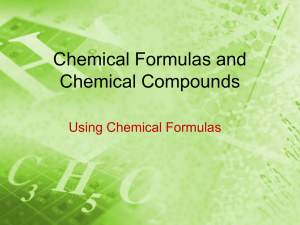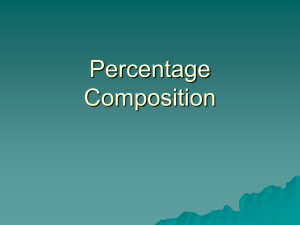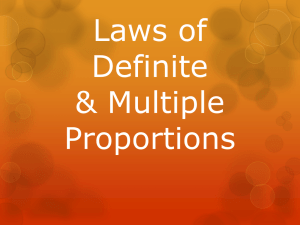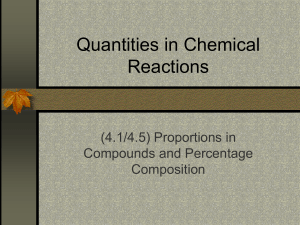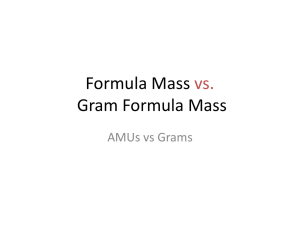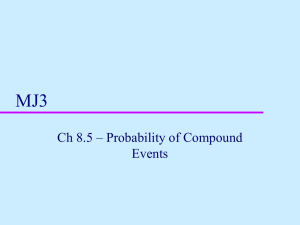Molar Mass & Percent Composition
advertisement
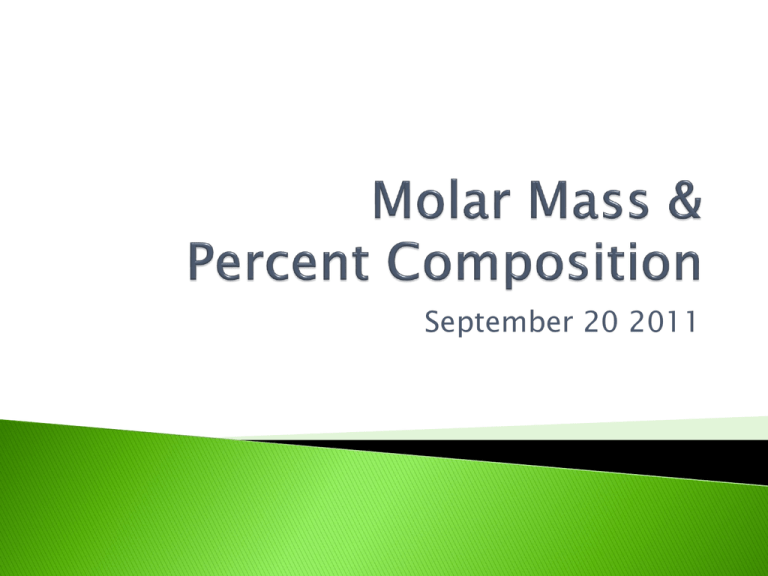
September 20 2011 Molar mass – the mass of one mole of a substance ◦ Gram formula mass (gfm) – mass in grams of one mole of an ionic compound ◦ Gram molecular mass (gmm) – mass in grams of one mole of a molecular compound To calculate molar mass… ◦ Add the atomic masses of each atom in a compound and switch the label from AMU to gram Find the gram formula mass of beryllium oxide ◦ Beryllium oxide = BeO Be = 9.0 AMU O = 16.0 AMU Total = 25.0 AMU -> 25.0 grams ◦ Lithium sulfide = Li2S ◦ Li = 4.0 AMU x 2 = 8.0 AMU ◦ S = 32.1 AMU 8.0 + 32.1 = 40.1 AMU -> 40.1 g If you have 100 coins and 30 of them are quarters, what percent of all your coins is quarters? percent = part/whole x 100 part = 30 and whole = 100 30/100 x 100= 30% Percent Composition: the percent by mass of each element in a compound To calculate percent composition, find the mass of the element and divide that by the total mass of the compound. % composition = mass of element x100 mass of compound In a sample of hydrogen peroxide, the mass of hydrogen is 2.0 grams and the total mass of the compound is 34.0 grams. Find the percent composition of hydrogen in hydrogen peroxide. 8.20 g of magnesium combines with 5.40 g of oxygen to form a compound. Find the percent composition of this compound… Total mass = 8.20g + 5.40g = 13.6g %Mg = 8.20g/13.6g x100 = 60.3% %O = 5.40g/13.6g x100 = 39.7% ◦ Check… 60.3% + 39.7% = 100% 29.0 g Ag combine with 4.30 g S to form a compound. Find the percent composition. ◦ Hint… don’t forget to find the total mass of the whole compound! ◦ Total mass = 29.0g + 4.30g = 33.30g ◦ %Ag = 29.0g/33.30g x100 = 87.1% ◦ %S = 4.30g/33.30g x100 = 12.9% Check…. 87.1% + 12.9% = 100% Propane is C3H8. Use molar mass to find percent composition. ◦ Use the periodic table to find the atomic mass of each element… ◦ ◦ ◦ ◦ ◦ ◦ ◦ C=12.0AMU and H = 1.0AMU and change that to molar mass C = 12.0g and H = 1.0g Three carbon atoms in the formula = 12.0g x 3 = 36.0g Eight hydrogen atoms = 1.0g x 8 = 8.0g Total molar mass of compound = 36.0 + 8.0 = 44.0g %C = 36.0g/44.0g x100 = 81.8% %H = 8.0g/44.0g x100 = 18.2% ◦ Check… 81.8% + 18.2% = 100% What is the mass of carbon in 82.0 g propane? ◦ Hint… use carbon’s percent composition! ◦ We just found that the percent of carbon in propane is 81.8%. That means that 81.8% of the mass of a sample of propane will be carbon. ◦ So to calculate the mass of carbon in 82.0 g, just multiply by the percent, 81.8%. Don’t forget to change the percent to a decimal! ◦ 82.0g x 0.818 = 67.1 g carbon That means that in 82.0g propane, there are 67.1 g carbon Empirical Formula: formula with the lowest wholenumber ratio of elements in a compound ◦ In other words… reduce the fraction! ◦ Glucose : C6H12O6 ◦ Benzene: C6H6 ◦ Ribose: C5H10O5 ratio is 6:12:6… you can divide each of those by 6 and get 1:2:1 so the empirical formula is C1H2O1 or CH2O ratio is 6:6, divide both by 6 and get 1:1…. CH ratio is 5:10:5, divide each by 5 and get 1:2:1…. CH2O S2Cl2 divide both by 2… SCl C6H10O4 divide all by 2, C3H5O2 H2O2 HO Find percent composition ◦ Carbon is black, oxygen is red, hydrogen is white ◦ ◦ ◦ ◦ ◦ ◦ ◦ ◦ ◦ ◦ Use the periodic table to mind atomic mass…. C=12.0AMU, O=16.0AMU, H=1.0AMU Count the atoms to write the chemical formula… C3H6O Molar mass: C=12.0g x 3 = 36.0g H=1.0g x 6 = 6.0g O = 16.0g Add all the masses to find total gram molecular mass… 36.0g+6.0g+16.0g=58.0g %C=36.0g/58.0g = 62.1% %H=6.0g/58.0g = 10.3% %O=16.0g/58.0g = 27.6% Check… 62.1%+10.3%+27.6%=100% Write the empirical formula of acetone… C3H6O… can’t be reduced

